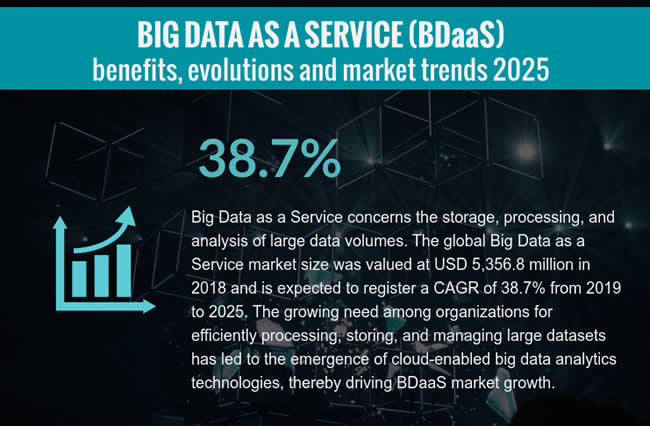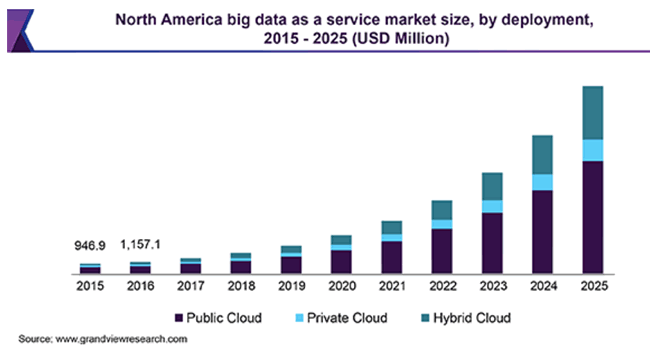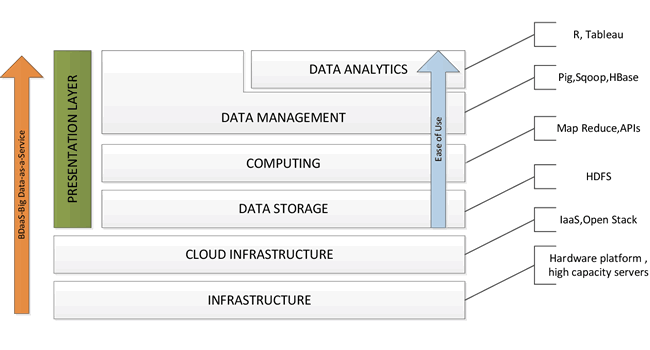Several big data management and analytics functions are available through ‘as-a-Service models in the cloud since the early days of big data.
Initially referring to various types of such big data management services, Big Data as a Service (BDaaS) has evolved into a booming market with solutions aiming to bring the power of big data analytics to a broader number of organizations and functions across several industries.

Combine big data technologies with cloud computing, and you have ‘Big Data as a Service’ (BDaaS) and many of the benefits offered by BDaaS. These benefits obviously relate to those that are associated with cloud deployment and delivery models: lower costs, the ability to focus on the outcomes (analytics etc.) instead of the infrastructure and technological aspects, less time and resources needed (including skilled data scientists), a viable option for a broader number of different companies (including medium-sized and small ones), flexibility, opex with pay-as-you-go-models, etc. And there are more.
Cloud and big data technologies are partners in enabling organizations to manage (store, process, analyze, visualize, etc.) all that data. In 2018, 73% of businesses were already performing big data processing in the cloud.
You could see Big Data as a Service or BDaaS as an umbrella term that is used for various services concerning data management functions that run in the cloud, in analogy with the XaaS models which we know from cloud computing (with SaaS, IaaS and PaaS as the main categories that are also applicable to big data).
The global big data as a service (BDaaS) market is estimated to reach USD 51.9 billion by 2025, registering a CAGR of 38.7% over the forecast period
Big data as a service in flux – the market, segments, current drivers and future drivers
However, today’s BDaaS vendors have an integrated approach with several tools combining various as-a-Service big data functions and often additional capabilities (e.g., by working with partners in fields such as cybersecurity or by offering advanced features leveraging new technologies).
Still, there are several categories of solutions such as Hadoop-as-a-Service, Data-as-a-Service and Data Analytics-as-a-Service.
Big Data as a Service has been defined as a framework of cloud-based, distributed computing technologies enabling end users to work with big data. The growth of the BDaaS market so far was, among others, driven by the increasing usage of big data management and analytics tools by somewhat smaller organizations for their digital transformation needs and by verticals such as financial services, manufacturing, retail, and ICT. Although SMBs have invested quite a bit in Big Data as a Service, they certainly aren’t the only ones (large enterprises account for most BDaaS spending as you can read at the end of this article).
Big Data as a Service, which is a combination of big data technologies and cloud computing platforms, helps users to reduce the cost and time for the deployment of big data projects. Moreover, BDaaS enables organizations to manage big data on the cloud and allows all departments to easily access data at any given time
Big Data as a Service concerns the storage, processing, and analysis of large data volumes with additional functionalities as the market of vendors evolves. As 1) everything becomes data-driven, 2) the global datasphere keeps growing significantly with among others IoT data (and cloud becoming more prominent in the core of the network) and 3) the usage of big data analytics and AI/ML is still growing across several business functions, the Big-Data-as-a-Service market continues to display high growth rates.
Grand View Research (report September 2019) expects the Big-Data-as-a-Service market to reach USD 51.9 billion by 2025. That’s a compound annual growth rate (CAGR) of 38.7 percent over the forecast period (2019-2025).
The main driver of this growth is the increasing need for organizations to make the most of their data with the known benefits of the cloud and especially with cloud-enabled big data analytics technologies (Data Analytics-as-a-Service) as another key driver. Grand View Research also points out the growing adoption of social media analytics that contributes to increased BDaaS demand. Other drivers – per the company – include the growing need to analyze and leverage structured data, mainly in developing countries, and the increasing adoption of Data Driven Decision Making (DDDM).
Early 2019, Market Insights Reports also looked at the Big-Data-as-a-Service Market, predicting a CAGR of 15.73 percent during the forecast period 2018-2023 whereby the global BDaaS market would reach a value of USD 38.06 billion by 2023.
This research found that the banking, financial services, and insurance segment (BFSI) accounts for the largest share of BDaaS spending. Grand View Research confirms this.
Big Data as a Service has emerged as the primary data source for retail organizations, through which they get immediate feedback about their products and services.
The substantial growth of the BFSI segment in BDaaS spending is explained by increasing regulatory scrutiny combined with improved customer satisfaction, including benefits such as fraud detection, risk management, and customized solutions. In another industry, retail, Big Data as a Service has emerged as the primary data source, the announcement states.
Manufacturing also remains essential and will be even more so in these days of IIoT and Industry 4.0 (mass-customization being one of the emphasized use cases). Manufacturing is expected to grow at a high CAGR during the forecast period, as is the case for the last industry that gets mentioned; IT & telecommunication.
From a cloud deployment perspective, the hybrid cloud Big-Data-as-a-Service segment is expected to grow fastest during the period 2019-2025 with a CAGR of over 40 percent according to Grand View Research; probably not a surprise.
In the debates about whether public cloud or private cloud is the best route to take regarding big data analytics you might also remember that in September 2018 Dell EMC teamed up with BlueData to bring a Big Data as a Service package for on-premises data centers as NetworkWorld wrote, pointing to the rationale of both companies to do so and launch a new phase in BDaaS.
From a solutions perspective the report looks at Hadoop-as-a-Service (20% of BDaaS market share in 2018), Data-as-a-Service and Data Analytics-as-a-Service (DAaaS, expected to be boosted by several factors).
Large enterprises lead big data as a service investment
As mentioned, the SMB market doesn’t account for the largest share of the Big-Data-as-a-Service market. Small- and medium-sized businesses only accounted for around a quarter of the USD 5,356.8 million value of the BDaaS market in 2018. However, during the forecast period, the small and medium-sized business segment is expected to grow fastest.

The fact that the large enterprise segment accounted for the largest market share in 2018 can be attributed to the rapidly increasing number of datasets coupled with various handling solutions such as data warehousing, data transformation, data migration, and data hub, according to Grand View Research. The company states that the growing involvement of banking and financial institutions to design, develop, and support ETL for their large datasets is anticipated to propel the market growth.
It should be reminded that the benefits of Big Data as a Service aren’t just about less need for upfront investments in building big data infrastructure, management costs, skills and so forth.
Again, not all BDaaS solutions are the same (e.g., different types and differences regarding aspects such as security and data governance, advanced analytical capabilities, visualization, an end-to-end approach) and, as Markets Insights Reports points out, the increased flexibility and customization to analyze and manipulate data, thus offering improved data and information management and accessibility to complex data analysis, makes Big Data as a Service a viable solution for large businesses that handle enormous amounts of data.

All images belong to their respective mentioned owners.

